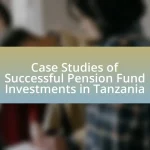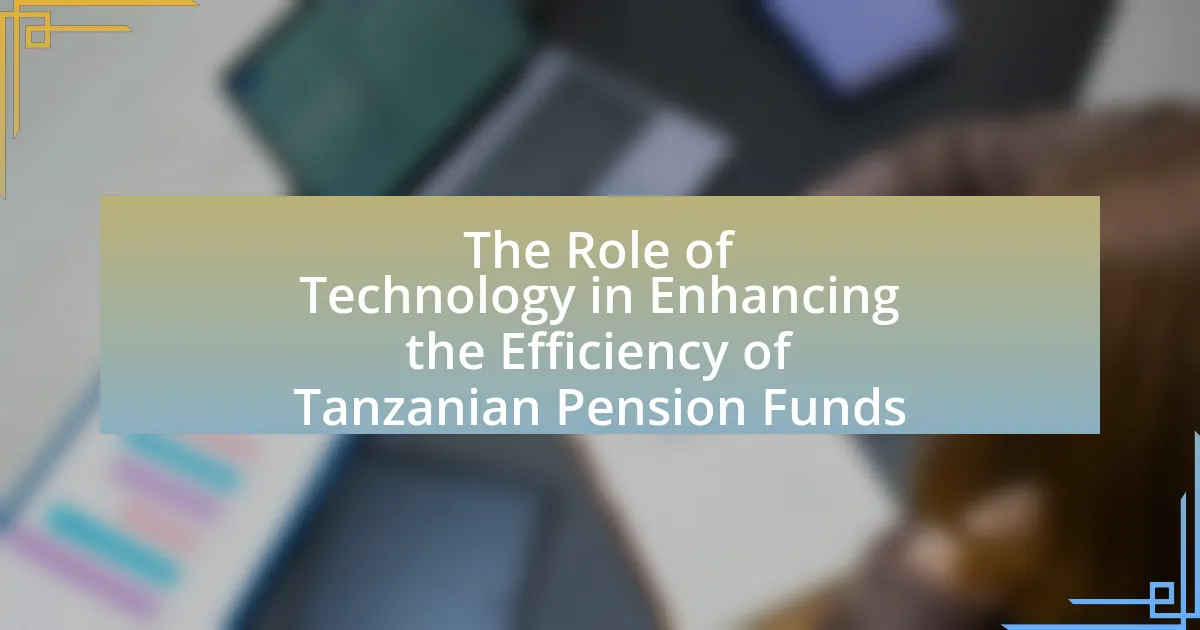The article focuses on the future trends in the Tanzanian pension fund sector and their economic implications. Key trends include increased digitalization, diversification of investment portfolios, and enhanced regulatory frameworks, which aim to improve accessibility and sustainability of pension funds. Demographic changes, particularly an aging population and urbanization, are influencing pension fund management and investment strategies. Technological advancements and fintech innovations are transforming operations, while regulatory changes are expected to strengthen governance and transparency. The article also discusses the economic implications of these trends, including capital mobilization for infrastructure development and the potential risks associated with market volatility and demographic shifts.

What are the Future Trends in the Tanzanian Pension Fund Sector?
The future trends in the Tanzanian pension fund sector include increased digitalization, diversification of investment portfolios, and enhanced regulatory frameworks. Digitalization is expected to streamline operations and improve accessibility for contributors, as evidenced by the growing adoption of mobile banking and fintech solutions in Tanzania. Diversification of investment portfolios will likely focus on infrastructure projects and real estate, driven by the government’s push for economic development and urbanization. Enhanced regulatory frameworks are anticipated to strengthen governance and transparency, aligning with global best practices, as seen in recent reforms aimed at improving the sustainability of pension funds. These trends collectively aim to bolster the sector’s resilience and ensure better retirement outcomes for beneficiaries.
How are demographic changes influencing the pension fund sector in Tanzania?
Demographic changes are significantly influencing the pension fund sector in Tanzania by altering the age distribution of the population and increasing life expectancy. As the population ages, there is a growing number of retirees who rely on pension funds for income, which increases the demand for sustainable pension schemes. According to the National Bureau of Statistics, the proportion of the population aged 60 and above is projected to rise from 5% in 2020 to 10% by 2050, indicating a substantial shift that necessitates adjustments in pension fund management and investment strategies to ensure long-term viability. Additionally, the increasing youth population, which constitutes a large part of the workforce, presents both challenges and opportunities for pension funds to attract new contributors and adapt to changing employment patterns.
What is the impact of an aging population on pension fund sustainability?
An aging population negatively impacts pension fund sustainability by increasing the ratio of beneficiaries to contributors. As life expectancy rises, more individuals draw pensions for longer periods while fewer workers contribute to the fund, leading to financial strain. For instance, in Tanzania, projections indicate that the dependency ratio will rise significantly, with the number of retirees expected to increase by 50% over the next two decades. This demographic shift can result in higher payouts and lower contributions, jeopardizing the long-term viability of pension systems.
How does urbanization affect pension fund contributions and withdrawals?
Urbanization increases pension fund contributions due to higher employment rates and income levels in urban areas, leading to more individuals participating in formal employment and contributing to pension schemes. As urban populations grow, the demand for jobs typically rises, resulting in more people being enrolled in pension plans, which boosts overall contributions. Conversely, urbanization can lead to increased withdrawals from pension funds as individuals may relocate for better opportunities or face higher living costs, prompting them to access their savings earlier. This dynamic is evident in Tanzania, where urban migration has been linked to both increased formal employment and a rise in early withdrawals from pension funds, reflecting the dual impact of urbanization on contributions and withdrawals.
What technological advancements are shaping the Tanzanian pension fund sector?
Technological advancements such as digital platforms, mobile applications, and data analytics are significantly shaping the Tanzanian pension fund sector. Digital platforms enable efficient management of pension contributions and withdrawals, while mobile applications facilitate easy access for members to monitor their accounts and make transactions. Data analytics enhances decision-making by providing insights into member behavior and investment performance, allowing pension funds to optimize their portfolios. These advancements are supported by the increasing internet penetration in Tanzania, which reached approximately 47% in 2023, fostering greater engagement and accessibility in the pension sector.
How is digitalization transforming pension fund management?
Digitalization is transforming pension fund management by enhancing operational efficiency, improving data analytics, and facilitating better customer engagement. The integration of technology allows pension funds to automate processes such as contributions, withdrawals, and reporting, which reduces administrative costs and errors. For instance, the use of advanced data analytics enables fund managers to assess investment risks and opportunities more accurately, leading to optimized portfolio management. Additionally, digital platforms improve communication with members, providing real-time access to account information and personalized services. According to a report by Deloitte, digital transformation in financial services, including pension management, can lead to a 30% reduction in operational costs and a significant increase in customer satisfaction.
What role do fintech innovations play in enhancing pension fund accessibility?
Fintech innovations significantly enhance pension fund accessibility by streamlining processes and reducing barriers for users. These technologies, such as mobile applications and blockchain, facilitate easier account management, lower transaction costs, and provide real-time data access. For instance, mobile money platforms in Tanzania have enabled individuals to contribute to pension funds directly from their phones, increasing participation rates among the unbanked population. According to a report by the World Bank, the integration of fintech in financial services has led to a 20% increase in financial inclusion in developing countries, demonstrating the effectiveness of these innovations in making pension funds more accessible.
What regulatory changes are expected in the Tanzanian pension fund sector?
Regulatory changes expected in the Tanzanian pension fund sector include the implementation of stricter governance frameworks and enhanced transparency requirements. The Tanzanian government aims to improve the management of pension funds by introducing regulations that mandate regular audits and disclosures, ensuring that fund managers adhere to best practices. These changes are driven by the need to protect beneficiaries’ interests and enhance the overall stability of the pension system, as evidenced by the government’s ongoing efforts to align with international standards and recommendations from organizations such as the International Labour Organization.
How will new policies affect pension fund investment strategies?
New policies will significantly reshape pension fund investment strategies by introducing stricter regulations and encouraging diversification into alternative assets. For instance, the Tanzanian government has implemented policies aimed at increasing the allocation of pension funds into infrastructure projects, which can enhance long-term returns and support national development. According to the National Social Security Fund (NSSF) of Tanzania, these policies are designed to ensure that pension funds not only secure retirees’ benefits but also contribute to economic growth, thereby creating a dual mandate for fund managers. This shift towards infrastructure investment is supported by the government’s focus on sustainable development goals, which further validates the need for pension funds to adapt their strategies in response to evolving regulatory frameworks.
What are the implications of international standards on local pension funds?
International standards significantly influence local pension funds by enhancing governance, risk management, and investment strategies. These standards, such as those set by the International Financial Reporting Standards (IFRS) and the International Organization of Pension Supervisors (IOPS), promote transparency and accountability, which are crucial for attracting both domestic and foreign investments. For instance, adherence to these standards can lead to improved financial reporting, enabling pension funds to better assess their financial health and make informed investment decisions. Additionally, compliance with international standards can facilitate cross-border investments, allowing local pension funds to diversify their portfolios and potentially increase returns. This alignment with global best practices ultimately strengthens the stability and sustainability of the pension fund sector, contributing to economic growth in Tanzania.

What are the Economic Implications of These Trends?
The economic implications of trends in the Tanzanian pension fund sector include increased capital mobilization for infrastructure development and enhanced financial stability for retirees. As pension funds grow, they can invest in long-term projects, which stimulates economic growth; for instance, the National Social Security Fund (NSSF) has invested in various sectors, contributing to job creation and improved public services. Additionally, a robust pension system can reduce poverty among the elderly, as evidenced by studies showing that countries with strong pension systems experience lower rates of senior poverty. This dual impact of fostering economic development while providing social security underscores the significance of evolving pension fund trends in Tanzania.
How will future trends in the pension fund sector impact national economic growth?
Future trends in the pension fund sector will significantly impact national economic growth by increasing capital availability for investment in infrastructure and development projects. As pension funds evolve to adopt more diversified investment strategies, they will allocate a larger portion of their assets to domestic markets, which can stimulate economic activity. For instance, the World Bank reports that pension funds in emerging markets, including Tanzania, have the potential to mobilize billions of dollars for long-term investments, thereby enhancing job creation and productivity. Additionally, improved regulatory frameworks and transparency in the pension sector can attract foreign investment, further bolstering economic growth.
What is the relationship between pension fund investments and infrastructure development?
Pension fund investments are crucial for infrastructure development as they provide long-term capital necessary for large-scale projects. These funds typically seek stable, long-term returns, making infrastructure investments attractive due to their potential for steady cash flows and low correlation with traditional asset classes. For instance, in Tanzania, pension funds have increasingly allocated resources to infrastructure projects, which not only enhance economic growth but also improve the overall investment landscape. According to the World Bank, investments in infrastructure can yield significant economic returns, with every dollar spent generating approximately $1.50 in economic output. This relationship underscores the importance of pension funds in financing infrastructure, thereby driving national development and economic stability.
How do pension funds contribute to financial market stability in Tanzania?
Pension funds contribute to financial market stability in Tanzania by providing a stable source of long-term capital for investments. This stability is crucial as pension funds typically invest in a diversified portfolio of assets, including government bonds and equities, which helps to reduce market volatility. For instance, as of 2021, pension funds in Tanzania managed assets worth approximately 4 trillion Tanzanian Shillings, which supports infrastructure development and economic growth. By maintaining a steady flow of capital into the financial markets, pension funds help to mitigate the effects of economic downturns and enhance overall market resilience.
What are the potential risks associated with the evolving pension fund landscape?
The potential risks associated with the evolving pension fund landscape include market volatility, regulatory changes, and demographic shifts. Market volatility can lead to significant fluctuations in asset values, impacting the funding status of pension plans. Regulatory changes may impose new compliance requirements, increasing operational costs and complexity for pension funds. Additionally, demographic shifts, such as an aging population, can strain pension systems by increasing the number of beneficiaries relative to active contributors, potentially leading to funding shortfalls. These risks are critical as they can affect the sustainability and reliability of pension funds in the long term.
How can market volatility affect pension fund returns?
Market volatility can significantly impact pension fund returns by affecting the value of the assets held within the fund. When market conditions fluctuate, the prices of stocks, bonds, and other investments can rise or fall sharply, leading to potential gains or losses for pension funds. For instance, during periods of high volatility, pension funds may experience decreased asset values, which can result in lower overall returns. Historical data shows that in 2008, during the financial crisis, many pension funds saw their returns drop by as much as 20% due to market instability. This volatility can also influence the fund’s ability to meet future liabilities, as lower returns may necessitate increased contributions from employers and employees to maintain funding levels.
What measures can be taken to mitigate risks in pension fund management?
To mitigate risks in pension fund management, diversification of investment portfolios is essential. By spreading investments across various asset classes, such as equities, bonds, and real estate, pension funds can reduce exposure to any single economic downturn. Additionally, implementing robust risk assessment frameworks allows for the identification and quantification of potential risks, enabling proactive management strategies. Regulatory compliance is also critical; adhering to established guidelines helps ensure that pension funds operate within safe parameters. Historical data shows that pension funds with diversified portfolios and strong risk management practices tend to achieve more stable returns, thereby safeguarding beneficiaries’ interests.

What Strategies Can Stakeholders Adopt to Adapt to These Trends?
Stakeholders in the Tanzanian pension fund sector can adopt diversification of investment portfolios as a primary strategy to adapt to emerging trends. By investing in a mix of asset classes, including equities, real estate, and infrastructure, stakeholders can mitigate risks associated with market volatility and enhance returns. For instance, the World Bank reports that diversified portfolios can yield higher long-term growth, which is crucial for pension funds aiming to meet future liabilities. Additionally, stakeholders should leverage technology to improve operational efficiency and customer engagement, as digital platforms can streamline processes and enhance service delivery. According to a Deloitte study, technology adoption in financial services can lead to cost reductions of up to 30%, thereby increasing the sustainability of pension funds. Lastly, fostering partnerships with local businesses and government entities can create synergies that enhance investment opportunities and support economic growth, aligning with national development goals.
How can pension fund managers enhance their investment strategies in response to trends?
Pension fund managers can enhance their investment strategies by integrating data analytics and adopting a diversified investment approach. Utilizing advanced data analytics allows managers to identify emerging market trends and assess risk more effectively, leading to informed decision-making. For instance, a study by McKinsey & Company highlights that data-driven investment strategies can improve returns by up to 20% compared to traditional methods. Additionally, diversification across asset classes, including equities, bonds, and alternative investments, mitigates risk and capitalizes on various market conditions, as evidenced by the performance of diversified portfolios during economic downturns. This strategic combination of data analytics and diversification positions pension funds to adapt to changing economic landscapes and optimize returns.
What best practices should be implemented for sustainable investment?
Best practices for sustainable investment include integrating environmental, social, and governance (ESG) criteria into investment decision-making processes. This approach ensures that investments not only yield financial returns but also contribute positively to society and the environment. Research indicates that companies with strong ESG performance tend to have lower risks and better long-term financial performance, as evidenced by a 2020 study from the Global Sustainable Investment Alliance, which reported that sustainable investments reached $30.7 trillion globally, reflecting a 34% increase over two years. Additionally, engaging with companies to improve their sustainability practices and actively voting on shareholder resolutions related to ESG issues can further enhance the impact of sustainable investments.
How can diversification improve risk management for pension funds?
Diversification improves risk management for pension funds by spreading investments across various asset classes, which reduces the impact of poor performance in any single investment. By allocating funds to a mix of equities, bonds, real estate, and alternative investments, pension funds can mitigate volatility and enhance overall portfolio stability. Historical data shows that diversified portfolios tend to have lower risk and higher risk-adjusted returns compared to concentrated portfolios, as evidenced by studies indicating that a well-diversified fund can reduce the standard deviation of returns by up to 30%. This strategic approach allows pension funds to better withstand market fluctuations and achieve long-term financial goals.
What role do policymakers play in shaping a resilient pension fund sector?
Policymakers play a crucial role in shaping a resilient pension fund sector by establishing regulatory frameworks that ensure financial stability and protect beneficiaries’ interests. These frameworks include setting capital adequacy requirements, promoting transparency, and enforcing governance standards, which collectively enhance the sector’s resilience against economic shocks. For instance, the implementation of the Pension Reform Act in Tanzania has led to increased contributions and improved fund management practices, thereby strengthening the overall sustainability of pension funds. Additionally, policymakers facilitate the diversification of investment portfolios, which mitigates risks and enhances returns, further contributing to the sector’s robustness.
How can effective regulation support pension fund growth and stability?
Effective regulation can support pension fund growth and stability by establishing clear guidelines that promote transparency, risk management, and investment diversification. Regulations ensure that pension funds adhere to prudent investment practices, which can mitigate risks associated with market volatility. For instance, the International Monetary Fund (IMF) has noted that well-regulated pension systems can enhance financial stability by reducing systemic risks and fostering investor confidence. Additionally, regulations that require regular reporting and audits can help maintain accountability, ensuring that funds are managed effectively and in the best interest of beneficiaries. This structured oversight not only protects the assets of pension funds but also encourages long-term investment strategies that contribute to sustainable growth.
What collaborative efforts can be made between public and private sectors?
Collaborative efforts between public and private sectors can include public-private partnerships (PPPs) for infrastructure development, joint investment initiatives in pension funds, and shared research and development projects. For instance, in Tanzania, the government can partner with private pension funds to enhance investment in critical infrastructure, which can lead to improved economic growth and increased returns for pension fund members. Evidence from successful PPPs in other countries shows that such collaborations can lead to more efficient resource allocation and innovation, ultimately benefiting both sectors and the economy as a whole.
What practical steps can individuals take to prepare for future pension fund changes?
Individuals can prepare for future pension fund changes by diversifying their investment portfolios and staying informed about pension regulations. Diversification reduces risk by spreading investments across various asset classes, which can help mitigate the impact of potential pension fund changes. Staying informed about regulatory updates and market trends allows individuals to make timely adjustments to their retirement strategies. For instance, the Tanzanian pension sector has seen reforms aimed at increasing transparency and efficiency, which can affect fund performance and individual retirement outcomes. By actively managing their investments and understanding the evolving landscape, individuals can better position themselves for future changes in the pension fund sector.
How can individuals stay informed about pension fund developments?
Individuals can stay informed about pension fund developments by regularly accessing official pension fund websites, subscribing to financial news outlets, and participating in relevant seminars or webinars. Official pension fund websites provide updates on policy changes, investment performance, and regulatory developments, ensuring that individuals receive accurate and timely information. Financial news outlets often cover significant changes in the pension sector, including market trends and economic implications, which can help individuals understand the broader context. Additionally, attending seminars or webinars hosted by financial experts or pension fund managers allows individuals to engage directly with professionals and gain insights into future trends and strategies within the Tanzanian pension fund sector.
What strategies should individuals consider for personal retirement planning?
Individuals should consider a diversified investment strategy for personal retirement planning. This involves allocating assets across various investment vehicles such as stocks, bonds, and real estate to mitigate risk and enhance potential returns. According to a study by Vanguard, a diversified portfolio can reduce volatility and improve long-term performance, which is crucial for retirement savings. Additionally, individuals should regularly review and adjust their retirement plans to account for changes in income, expenses, and market conditions, ensuring that their strategies remain aligned with their retirement goals.





